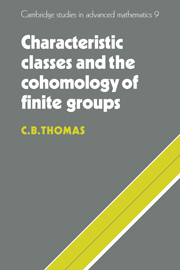Book contents
- Frontmatter
- Contents
- Introduction
- 1 Group cohomology
- 2 Products and change of group
- 3 Relations with subgroups and duality
- 4 Spectral sequences
- 5 Representations and vector bundles
- 6 Bundles over the classifying space for a discrete group
- 7 The symmetric group
- 8 Finite groups with p-rank ≤ 2
- 9 Linear groups over finite fields
- Appendix 1 The Riemann–Roch formula
- Appendix 2 Integral cohomology of non-abelian groups of order p3, p ≥ 3
- Appendix 3 Non-abelian groups of order p4, p ≥ 5
- References
- Index of symbols
- Index
8 - Finite groups with p-rank ≤ 2
Published online by Cambridge University Press: 05 November 2011
- Frontmatter
- Contents
- Introduction
- 1 Group cohomology
- 2 Products and change of group
- 3 Relations with subgroups and duality
- 4 Spectral sequences
- 5 Representations and vector bundles
- 6 Bundles over the classifying space for a discrete group
- 7 The symmetric group
- 8 Finite groups with p-rank ≤ 2
- 9 Linear groups over finite fields
- Appendix 1 The Riemann–Roch formula
- Appendix 2 Integral cohomology of non-abelian groups of order p3, p ≥ 3
- Appendix 3 Non-abelian groups of order p4, p ≥ 5
- References
- Index of symbols
- Index
Summary
At the end of Chapter 6 we gave a number of examples to show that it is possible for the subring of Chern classes to exhaust the even dimensional cohomology of a finite group. We propose to examine this phenomenon more carefully; as the examples suggest the relative ‘size’ of Ch(G) is closely connected to the abelian subgroup structure of G.
Definition
The p-rank (rkp) of the finite group G equals the dimension over Fp of a maximal elementary abelian p-subgroup K of G. Thus if K ≅ (ℤ/p) × … × (ℤ/p) (r copies), rkp(G) = r.
If rkp(G) = 1, a p-Sylow subgroup is either cyclic or generalised quaternion/binary dihedral (if p = 2). Thus rkp(G) = 1 if and only if H*(G, ℤ)(p) is periodic, see the final section of Chapter 3.
Abelian groups
Theorem 8.1
(i) H*(Cp, ℤ) = (ℤ/p) [α], dim (α) = 2.
(ii) H*(Cp × Cp, ℤ) = (ℤ/p) [α, β] ⊗ E(µ) if p is an odd prime, dim (α) = dim (β) = 2, and dim (µ) = 3.
(iii) Heven(Cp × Cp × Cp, ℤ) is generated over ℤ/p by elements α, β and γ of dimension 2 and by ξ of dimension 4.
Proof. Part (i) is familiar; parts (ii) and (iii) follow from the diagram
in which the two monomorphisms are reduction mod p.
- Type
- Chapter
- Information
- Characteristic Classes and the Cohomology of Finite Groups , pp. 91 - 101Publisher: Cambridge University PressPrint publication year: 1987

